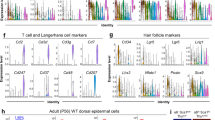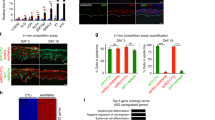Abstract
Various common signaling pathways maintain tissue stem cells, including Notch and Wnt/β-catenin signals. Phosphoinositide-3 kinase (PI3K)/Akt signaling regulates the ‘stemness’ of several stem cells in culture, specifically in maintaining embryonic stem and neural stem cells, and in deriving embryonic germ cells from primordial germ cells. We examined the effect of Akt signaling in epidermal cells in transgenic mice expressing an Akt-Mer fusion protein whose kinase activity was conditionally activated by treatment with 4-hydroxytamoxifen (4OHT). The topical application of 4OHT to adult skin of the transgenic mice induced new hair growth in resting phase follicles. In addition, the mice showed hyperplasia in interfollicular epidermis (IFE) and hair follicles, which was presumably caused by the extensive proliferation of keratinocytes in basal layer of IFE and outer root sheath of hair follicles, respectively. The progenitor cell population increased consistently in 4OHT-treated transgenic mice. Our results show that PI3K/Akt signaling induces epidermal hyperplasia and proliferation of epidermal progenitors.
This is a preview of subscription content, access via your institution
Access options
Subscribe to this journal
Receive 50 print issues and online access
$259.00 per year
only $5.18 per issue
Buy this article
- Purchase on Springer Link
- Instant access to full article PDF
Prices may be subject to local taxes which are calculated during checkout




Similar content being viewed by others
References
Backman SA, Ghazarian D, So K, Sanchez O, Wagner KU, Hennighausen L et al. (2004). Early onset of neoplasia in the prostate and skin of mice with tissue-specific deletion of Pten. Proc Natl Acad Sci USA 101: 1725–1730.
Blanpain C, Lowry WE, Geoghegan A, Polak L, Fuchs E . (2004). Self-renewal, multipotency, and the existence of two cell populations within an epithelial stem cell niche. Cell 118: 635–648.
Brazil DP, Yang ZZ, Hemmings BA . (2004). Advances in protein kinase B signalling: AKTion on multiple fronts. Trends Biochem Sci 29: 233–242.
Cantley LC . (2002). The phosphoinositide 3-kinase pathway. Science 296: 1655–1657.
Di-Poi N, Ng CY, Tan NS, Yang Z, Hemmings BA, Desvergne B et al. (2005). Epithelium–mesenchyme interactions control the activity of peroxisome proliferator-activated receptor beta/delta during hair follicle development. Mol Cell Biol 25: 1696–1712.
Fuchs E, Tumbar T, Guasch G . (2004). Socializing with the neighbors: stem cells and their niche. Cell 116: 769–778.
Gat U, DasGupta R, Degenstein L, Fuchs E . (1998). De novo hair follicle morphogenesis and hair tumors in mice expressing a truncated beta-catenin in skin. Cell 95: 605–614.
Ghazizadeh S, Taichman LB . (2001). Multiple classes of stem cells in cutaneous epithelium: a lineage analysis of adult mouse skin. EMBO J 20: 1215–1222.
Groszer M, Erickson R, Scripture-Adams DD, Lesche R, Trumpp A, Zack JA et al. (2001). Negative regulation of neural stem/progenitor cell proliferation by the Pten tumor suppressor gene in vivo. Science 294: 2186–2189.
Ito M, Liu Y, Yang Z, Nguyen J, Liang F, Morris RJ et al. (2005). Stem cells in the hair follicle bulge contribute to wound repair but not to homeostasis of the epidermis. Nat Med 11: 1351–1354.
Jones PH, Harper S, Watt FM . (1995). Stem cell patterning and fate in human epidermis. Cell 80: 83–93.
Kimura T, Suzuki A, Fujita Y, Yomogida K, Lomeli H, Asada N et al. (2003). Conditional loss of PTEN leads to testicular teratoma and enhances embryonic germ cell production. Development 130: 1691–1700.
Kishimoto H, Hamada K, Saunders M, Backman S, Sasaki T, Nakano T et al. (2003). Physiological functions of Pten in mouse tissues. Cell Struct Funct 28: 11–21.
Kohn AD, Barthel A, Kovacina KS, Boge A, Wallach B, Summers SA et al. (1998). Construction and characterization of a conditionally active version of the serine/threonine kinase Akt. J Biol Chem 273: 11937–11943.
Levy V, Lindon C, Harfe BD, Morgan BA . (2005). Distinct stem cell populations regenerate the follicle and interfollicular epidermis. Dev Cell 9: 855–861.
Littlewood TD, Hancock DC, Danielian PS, Parker MG, Evan GI . (1995). A modified oestrogen receptor ligand-binding domain as an improved switch for the regulation of heterologous proteins. Nucleic Acids Res 23: 1686–1690.
Lo Celso C, Prowse DM, Watt FM . (2004). Transient activation of beta-catenin signalling in adult mouse epidermis is sufficient to induce new hair follicles but continuous activation is required to maintain hair follicle tumours. Development 131: 1787–1799.
Morris RJ, Tacker KC, Baldwin JK, Fischer SM, Slaga TJ . (1987). A new medium for primary cultures of adult murine epidermal cells: application to experimental carcinogenesis. Cancer Lett 34: 297–304.
Muller-Rover S, Handjiski B, van der Veen C, Eichmuller S, Foitzik K, McKay IA et al. (2001). A comprehensive guide for the accurate classification of murine hair follicles in distinct hair cycle stages. J Invest Dermatol 117: 3–15.
Okabe M, Ikawa M, Kominami K, Nakanishi T, Nishimune Y . (1997). Green mice' as a source of ubiquitous green cells. FEBS Lett 407: 313–319.
Peng XD, Xu PZ, Chen ML, Hahn-Windgassen A, Skeen J, Jacobs J et al. (2003). Dwarfism, impaired skin development, skeletal muscle atrophy, delayed bone development, and impeded adipogenesis in mice lacking Akt1 and Akt2. Genes Dev 17: 1352–1365.
Sarin KY, Cheung P, Gilison D, Lee E, Tennen RI, Wang E et al. (2005). Conditional telomerase induction causes proliferation of hair follicle stem cells. Nature 436: 1048–1052.
Silva-Vargas V, Lo Celso C, Giangreco A, Ofstad T, Prowse DM, Braun KM et al. (2005). Beta-catenin and Hedgehog signal strength can specify number and location of hair follicles in adult epidermis without recruitment of bulge stem cells. Dev Cell 9: 121–131.
Stenn KS, Paus R . (2001). Controls of hair follicle cycling. Physiol Rev 81: 449–494.
Suzuki A, Itami S, Ohishi M, Hamada K, Inoue T, Komazawa N et al. (2003). Keratinocyte-specific Pten deficiency results in epidermal hyperplasia, accelerated hair follicle morphogenesis and tumor formation. Cancer Res 63: 674–681.
Van Mater D, Kolligs FT, Dlugosz AA, Fearon ER . (2003). Transient activation of beta-catenin signaling in cutaneous keratinocytes is sufficient to trigger the active growth phase of the hair cycle in mice. Genes Dev 17: 1219–1224.
Watanabe S, Umehara H, Murayama K, Okabe M, Kimura T, Nakano T . (2006). Activation of Akt signaling is sufficient to maintain pluripotency in mouse and primate embryonic stem cells. Oncogene 25: 2697–2707.
Watt FM . (2001). Stem cell fate and patterning in mammalian epidermis. Curr Opin Genet Dev 11: 410–417.
Yang ZZ, Tschopp O, Di-Poi N, Bruder E, Baudry A, Dummler B et al. (2005). Dosage-dependent effects of Akt1/protein kinase Balpha (PKBalpha) and Akt3/PKBgamma on thymus, skin, and cardiovascular and nervous system development in mice. Mol Cell Biol 25: 10407–10418.
Yilmaz OH, Valdez R, Theisen BK, Guo W, Ferguson DO, Wu H et al. (2006). Pten dependence distinguishes haematopoietic stem cells from leukaemia-initiating cells. Nature 441: 475–482.
Zhang J, Grindley JC, Yin T, Jayasinghe S, He XC, Ross JT et al. (2006). PTEN maintains haematopoietic stem cells and acts in lineage choice and leukaemia prevention. Nature 441: 518–522.
Acknowledgements
We thank Ms A Kawai and Y Koreeda for assistance in generation of transgenic mice. KM is supported by scholarship from the Japanese Society for Promotion of Science. Animal care was in accordance with the guidelines of Osaka University. This work is supported in part by grants from the Ministry of Education, Science, Sports and Culture, Astellas Foundation for Research on Metabolic Disorders and the 21st Century COE ‘CICET’.
Author information
Authors and Affiliations
Corresponding authors
Additional information
Supplementary Information accompanies the paper on the Oncogene website (http://www.nature.com/onc).
Rights and permissions
About this article
Cite this article
Murayama, K., Kimura, T., Tarutani, M. et al. Akt activation induces epidermal hyperplasia and proliferation of epidermal progenitors. Oncogene 26, 4882–4888 (2007). https://doi.org/10.1038/sj.onc.1210274
Received:
Revised:
Accepted:
Published:
Issue Date:
DOI: https://doi.org/10.1038/sj.onc.1210274
Keywords
This article is cited by
-
AKT signaling is associated with epigenetic reprogramming via the upregulation of TET and its cofactor, alpha-ketoglutarate during iPSC generation
Stem Cell Research & Therapy (2021)
-
Priming mobilization of hair follicle stem cells triggers permanent loss of regeneration after alkylating chemotherapy
Nature Communications (2019)
-
The role of PI3K/AKT/FOXO signaling in psoriasis
Archives of Dermatological Research (2019)
-
Comparative gene expression profiling reveals key pathways and genes different in skin epidermal stem cells and corneal epithelial cells
Genes & Genomics (2019)
-
Oncogenic activation of PI3K induces progenitor cell differentiation to suppress epidermal growth
Nature Cell Biology (2018)



